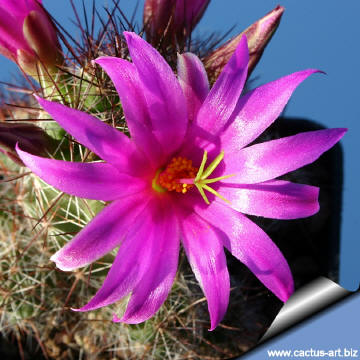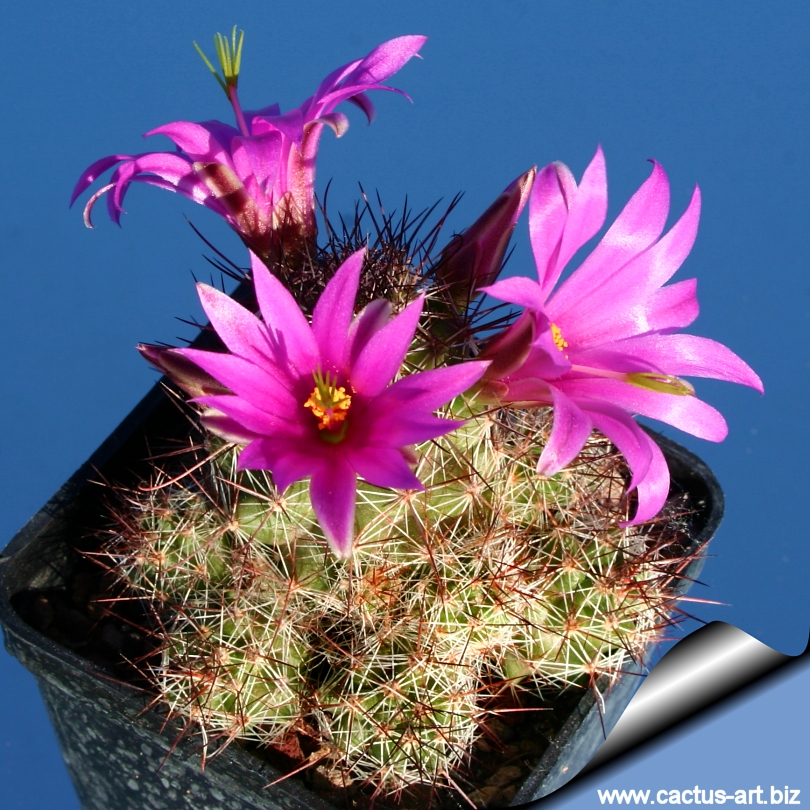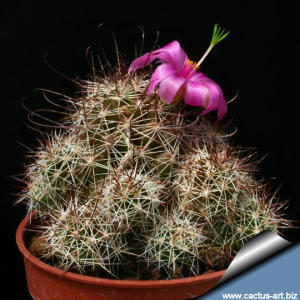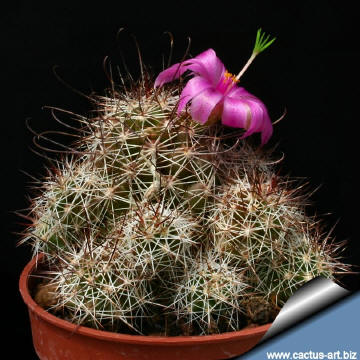|
Flowers wide purplish pink ,style pink with nice green stigma-lobes
Bloomis in April and the flowers remain open for several days (at least three).
Family: Cactaceae (Cactus Family)
Mammillaria swinglei (Britton & Rose) Boed.
Scientific name: Mammillaria sheldonii (Britton & Rose) Boed.
First description: by Britton & Rose, The Cact. 4: 156 (1923).
Origin: Sonora, Mexico Altitude up to 1.200 m.
Conservation status: Listed in CITES appendix 2.
Synonyms:
- Neomammillaria swinglei
- Mammillaria inaia
- Mammillaria swinglei var diabloa
Mammillaria swinglei
(Now often considered a synonym of Mammillaria sheldonii to which it don’t shows significant differences)
|
|

|
Description: Branching basally to form clumps.
Stems: 10-25 cm tall , 3-5 cm in diameter, dull green, often becoming reddish. Without latex.
Tubercles: Cylindrical four-sided basally, keeled 7-10 mm long , 5-7 mm in diameter; axils without wool, but sometimes with a few more or less setose bristles. Tubercule arrangement: 8 - 13
Central spines: 1 to 4 brown needle-like ascending, dark brown or black, the lowest one elongated (up to 1.5 cm. long), hooked at apex or sometimes straight.
Radials: 11 to 18 obscuring the tubercles, 7-14 mm long, needle-like rather stout, spreading, dull white with dark tips.
Flowers: Wide funnelform purplish pink (White and yellow varieties are mentioned) inodorous 3 cm in diameter. Outer perianth-segments greenish or sometimes pinkish; margins somewhat scarious; inner perianth-segments narrowly oblong, nearly white with a brown stripe down center; style pink, twice as long as the pink filaments; stigma-lobes 8, linear, pointed, green;
Blooming season (Europe): April, In cultivation the flowers remain open for several days (at least three).
Fruit: Pale scarlet, clavate, 14 to 18 mm. long;
Seeds: 1 mm. in diameter, constricted below, black with a large elliptic basal hilum.
Cultivation: This plant blooms easily and needs lots of light. Use pot with good drainage and a very porous mineral-based potting mix. Pot plants are quite wet-sensitively, especially in light of its small root system. Water sparingly during the growing season, let soil dry in between to prevent root rot, keep very dry in winter. Feed with a high potassium fertilizer in summer.
Usually it is recommended to overwinter this plant in a bright and warm greenhouse with at least 8-10° C , but it proved to be quite frost resistant (if kept dry it hardy as low as -7° C) A resting period in winter and strong light are necessary so that it can flower properly. Plants will offset readily, and dense clumps can be produced in a very few years.
Propagation: Through seeds and cuttings.
|




